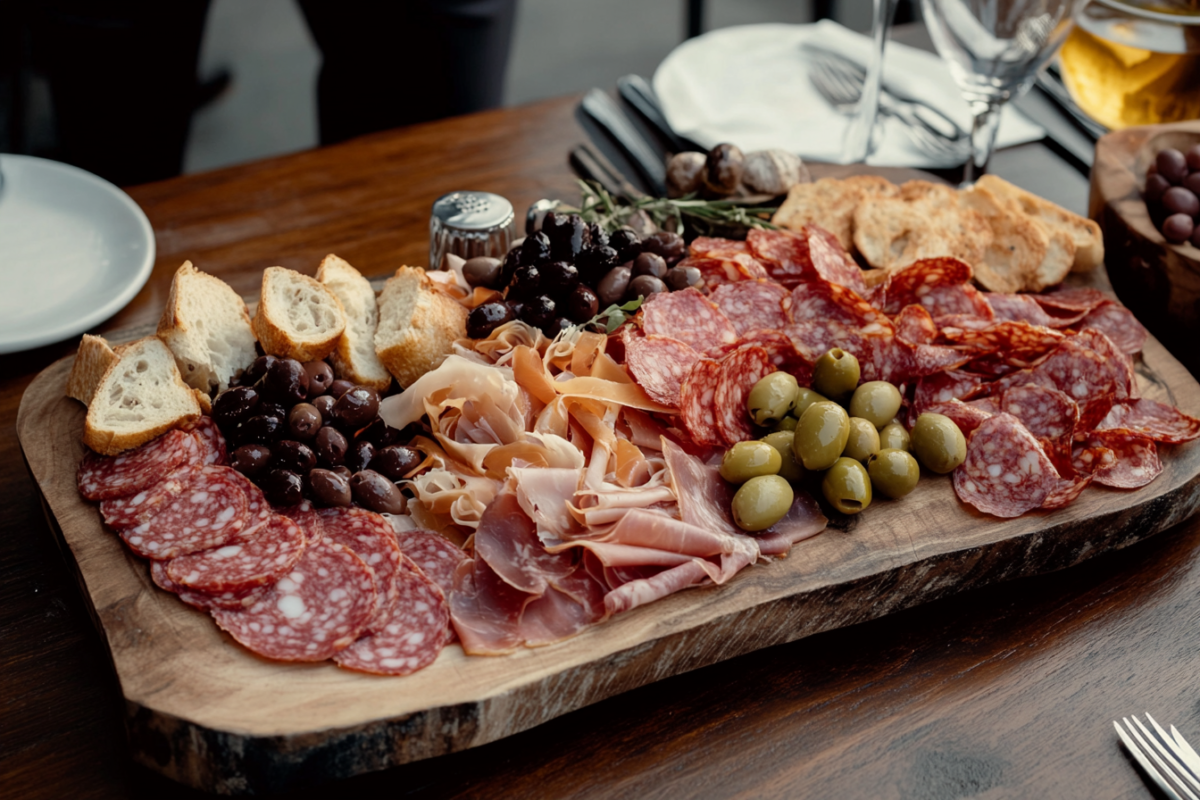Exploring the Rich Tradition of Italian Deli Meats
Introduction
Italian deli meats, collectively known as salumi, hold an undeniably cherished place in the world of cuisine. These flavorful and artisanal creations are far more than just food—they represent centuries of tradition, innovation, and a deep sense of regional pride. Every slice of Italian deli meats tells a captivating story, from the smoky, rich depths of speck to the delicate, sweet layers of prosciutto. These meats encapsulate the essence of Italy’s culinary artistry and regional pride. In this article, we’ll journey through their fascinating history, explore the diverse varieties, delve into intricate production techniques, and showcase their versatile culinary applications, uncovering the secrets behind their timeless charm and enduring global popularity.
Definition and Significance of Italian Deli Meats
Italian deli meats represent a diverse collection of cured and cooked meats, each crafted with remarkable precision and passion. Whether salted, smoked, or spiced, these delectable creations are celebrated for their rich flavors and exceptional versatility. They are staples in Italian households, often taking center stage in antipasto platters, hearty sandwiches, or elegantly paired with fine wines and artisan cheeses. Beyond their exquisite taste, Italian deli meats serve as cultural ambassadors, embodying the essence of Italy’s rich culinary heritage and bringing its timeless traditions to tables around the world.
Historical Evolution of Italian Cured Meats
Ancient Preservation Techniques
Long before refrigeration, curing meat was an essential survival skill. Ancient Italians mastered techniques like salting and air-drying to preserve their food. Over time, this necessity turned into an art form, giving birth to some of the world’s most iconic cured meats.
Influence of Regional Practices
Italy’s diverse geography and climate shaped its salumi traditions. For example, the lush plains of Parma provide the ideal conditions for aging prosciutto, while the Alpine regions are famous for their smoked and spiced specialties like speck. With its unique approach, each region contributed to the vibrant tapestry of Italian deli meats we enjoy today.
Categories of Italian Deli Meats
Cured vs. Cooked Varieties
Italian deli meats are broadly classified into two categories: cured meats and cooked meats. To begin with, cured meats, like prosciutto and salami, undergo a preservation process that includes salting, drying, or smoking. Moreover, this process not only extends shelf life but also intensifies the flavors, ultimately creating the rich, savory profiles we know and love.
On the other hand, cooked varieties, such as mortadella, are prepared by boiling the meat before seasoning. These meats have a softer texture and a milder flavor, making them ideal for various dishes. Whether cured or cooked, both categories reflect the deep culinary traditions of Italy.
Regional Specialties Across Italy
Italy’s regional diversity plays a vital role in shaping its salumi. The north offers delicacies like bresaola, an air-dried beef specialty from Lombardy, while central regions like Tuscany are known for their robust salami. With its spicy flair, Southern Italy contributes richly seasoned sausages like ‘nduja. Every region takes pride in its distinctive approach, ensuring a dazzling array of flavors for enthusiasts of Italian deli meats.
Detailed Overview of Popular Italian Deli Meats
Prosciutto: The Quintessential Italian Ham
Prosciutto di Parma
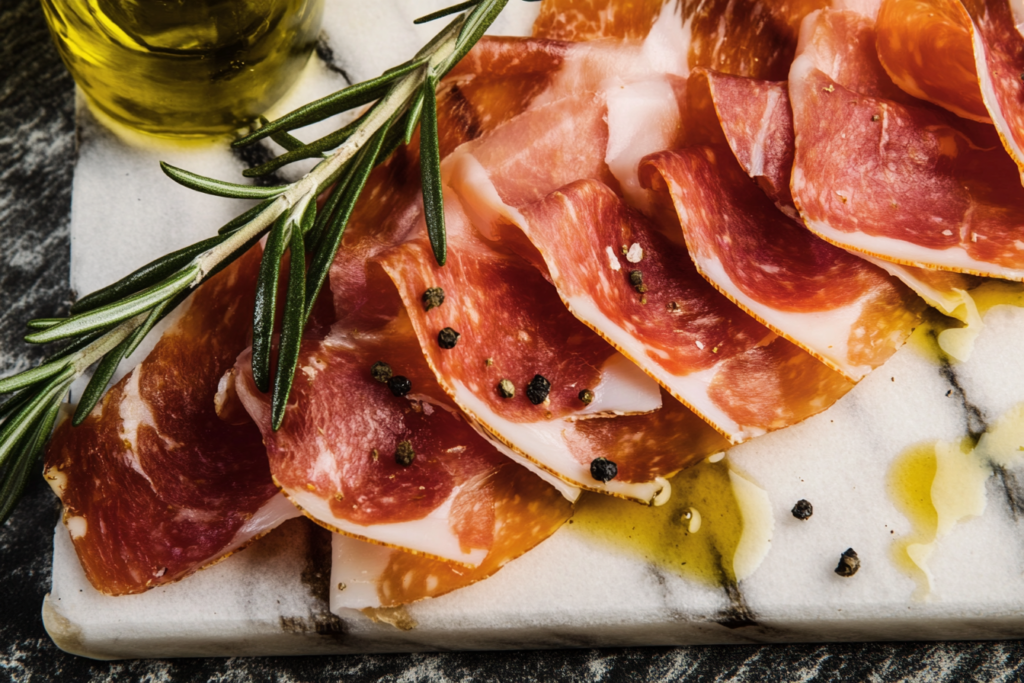
Hailing from Parma, Prosciutto di Parma is the most famous of all Italian deli meats. It is dry-cured with sea salt and aged for at least 12 months, producing a delicate buttery flavor. Its Protected Designation of Origin (DOP) status ensures authenticity, making it a global culinary treasure. Learn more about DOP certifications here.
Prosciutto di San Daniele
Prosciutto di San Daniele is crafted in Friuli Venezia Giulia, slightly sweeter and more aromatic than its Parma counterpart. The area’s microclimate, which combines Alpine air with Adriatic breezes, contributes to its unique flavor profile.
Salami Varieties: A Diverse Selection
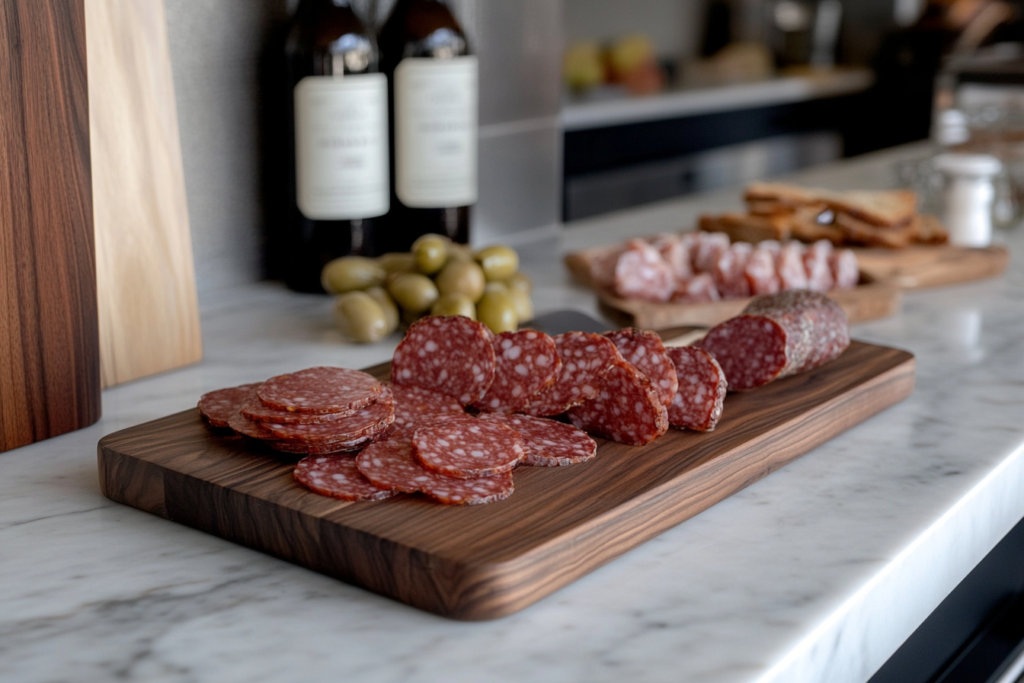
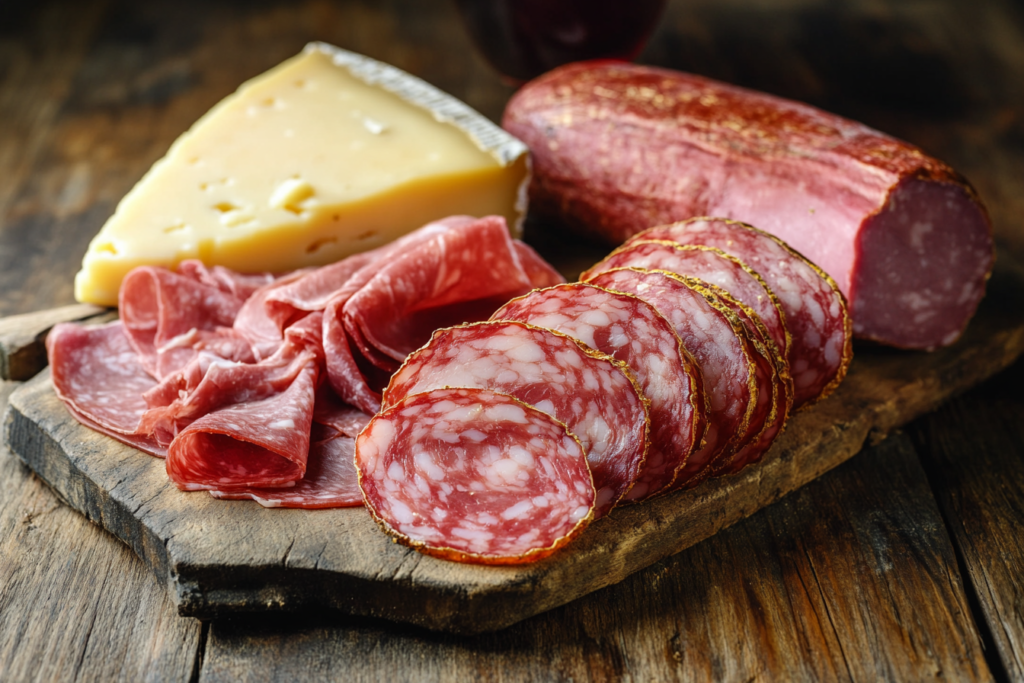
Genoa Salami
Renowned for its fine texture and mild yet savory taste, Genoa salami is expertly crafted from pork, garlic, and wine. Moreover, this classic Italian delicacy has become a beloved choice for both sandwiches and charcuterie boards. Its slightly tangy kick not only adds depth but also enhances the flavor of any dish it accompanies, making it an essential addition to countless culinary creations.
Milano Salami
Milano salami is produced in Milan with a firmer texture and a mild, nutty flavor. Its fine grind and balance of spices make it a versatile option for various dishes.
Specialty Meats: Unique Flavors
Mortadella
Often mistaken for bologna, mortadella is a delicately seasoned cooked meat, traditionally studded with pistachios or black peppercorns for added flavor and texture. Originating from Bologna, this classic Italian delicacy has become a staple in both Italian sandwiches and antipasti platters. Furthermore, its rich, buttery taste and smooth texture make it a versatile ingredient that elevates any dish it graces.
Bresaola
Bresaola, an air-dried, salted beef, is a delicacy from Lombardy. Its lean texture and slightly sweet flavor make it a healthier choice among Italian deli meats.
Speck
A smoked ham from South Tyrol, speck combines curing and smoking techniques to produce a deeply savory and slightly smoky taste. It pairs beautifully with rustic bread and sharp cheeses.
Production Processes and Ingredients
Traditional Production Methods
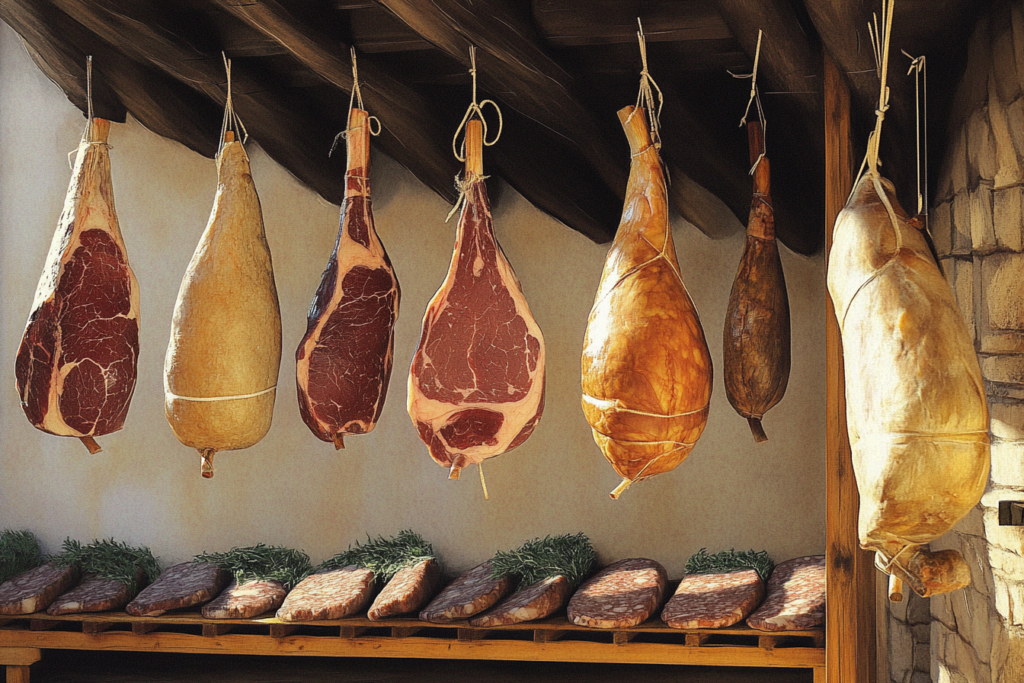
Curing and Aging Techniques
The hallmark of Italian deli meats lies in the meticulous curing and aging processes. These techniques involve salting, air-drying, and occasionally smoking the meat over weeks, months, or even years. For example, prosciutto undergoes a rigorous process where the meat is salted and left to rest, allowing the natural enzymes to enhance its flavor and tenderness. Similarly, salami is air-dried in controlled environments to develop its characteristic tangy taste.
Role of Spices and Herbs
From the aromatic rosemary in Tuscany to the bold red chili flakes of Calabria, Italian cured meats owe much of their distinctiveness to regional spices and herbs. These flavorings not only elevate the taste but also act as natural preservatives. Ingredients like garlic, fennel seeds, and juniper berries are carefully selected to complement the meat’s natural flavors.
Quality Control and Standards
Protected Designations (DOP and IGP)
Certifications like DOP (Denominazione di Origine Protetta) and IGP (Indicazione Geografica Protetta) often safeguard Italian cured meats. Specifically, these labels ensure that the meat is produced, processed, and packaged within specific regions while adhering to time-honored traditional methods. For instance, Prosciutto di Parma and Mortadella di Bologna proudly carry these prestigious marks. As a result, these standards not only guarantee authenticity but also ensure exceptional quality for consumers worldwide. To delve deeper, you can learn more about these certifications here.
Culinary Applications and Pairings
Incorporating Italian Deli Meats into Cuisine
Traditional Italian Dishes
Italian deli meats are integral to numerous traditional recipes. For example, prosciutto is often wrapped around fresh melon slices or stuffed into chicken breasts, adding a savory dimension. Salami frequently graces pizzas, while mortadella stars in creamy tortellini fillings. These meats elevate the taste and connect diners to Italy’s rich culinary heritage.
Modern Culinary Innovations
In recent years, chefs have been enthusiastically reimagining ways to use Italian deli meats. For example, you’ll often find crispy pancetta chips adding a delightful crunch to gourmet salads, spicy ‘nduja blended into creamy pasta sauces for a fiery kick, or speck artfully paired with exotic fruits to create a bold flavor contrast. Ultimately, the versatility of these meats opens the door to endless creativity in the kitchen, making them a staple for both traditional and modern culinary innovations.
Pairing Italian Deli Meats with Wines and Cheeses

Regional Pairing Recommendations
Pairing Italian deli meats with the right wine and cheese can truly transform any meal into a gourmet experience. For instance, Prosciutto di Parma pairs beautifully with a crisp dry prosecco or a nutty Parmigiano-Reggiano, enhancing its delicate flavors. Similarly, for salami, a robust red wine like Chianti perfectly balances its richness. Meanwhile, mortadella finds its ideal match in a creamy ricotta or a chilled Lambrusco, creating a delightful contrast of textures and tastes. Altogether, these thoughtful pairings bring out the nuanced flavors of each ingredient, resulting in a perfectly harmonious dining experience.
Health Considerations and Nutritional Information
Nutritional Profile of Italian Deli Meats
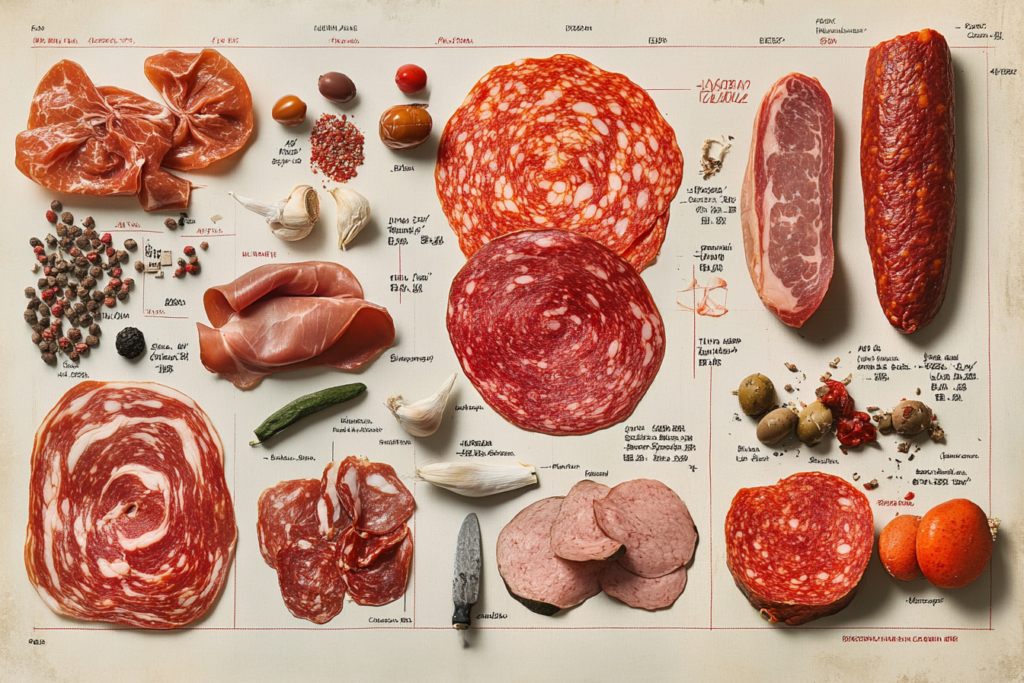
Protein and Fat Content
Italian deli meats are rich protein sources, making them popular for those seeking energy-dense foods. For instance, bresaola, made from lean beef, is high in protein and low in fat, making it a healthier option. On the other hand, meats like mortadella and pancetta are higher in fat, contributing to their luscious textures and bold flavors. Moderation is key, as these meats can add valuable nutrients to your diet.
Sodium Levels and Health Implications
Due to the curing process, Italian deli meats often contain higher sodium levels. While salt is integral to their preservation and flavor, excessive consumption could lead to health concerns, such as high blood pressure. It’s important to balance these indulgent treats with low-sodium foods and stay mindful of portion sizes.
Moderation and Dietary Recommendations
Balancing Indulgence with Health
The beauty of Italian cured meats lies in their bold, distinctive flavors, which means that even a small amount can make a big impact. For instance, savoring just a few slices of prosciutto alongside a crisp, fresh salad or incorporating salami into a well-balanced meal can deliver immense satisfaction without the risk of overindulgence. Furthermore, pairing these meats with wholesome ingredients such as whole grains, fresh vegetables, and healthy fats like olive oil ensures a delicious and nutritionally balanced diet.
FAQs About Italian Deli Meats
What distinguishes prosciutto from other hams?
Prosciutto is an uncooked, dry-cured ham aged for several months to develop its delicate, sweet flavor. Unlike cooked hams, prosciutto is thinly sliced and enjoyed raw.
How should Italian deli meats be stored?
To maintain freshness, Italian deli meats should be stored in the refrigerator, wrapped in wax paper or airtight containers. Avoid freezing, as it can alter the texture and flavor.
Are Italian deli meats safe to consume during pregnancy?
While some cured meats are safe if cooked, it’s best to avoid raw or undercooked deli meats during pregnancy due to the risk of listeria. Consult a healthcare provider for personalized advice.
What are the vegetarian alternatives to Italian deli meats?
Plant-based substitutes, like mushroom-based salami or seitan prosciutto, are gaining popularity. These options replicate the savory flavors and textures of traditional meats.
How are Italian deli meats incorporated into antipasto platters?
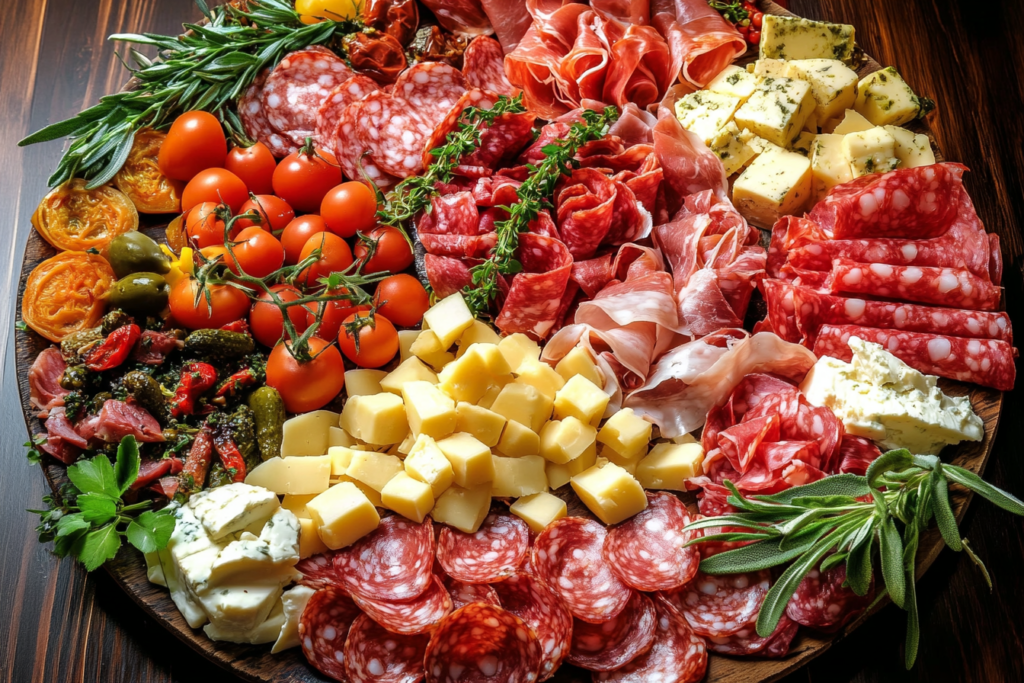
Antipasto platters often feature a variety of salumi alongside olives, cheeses, marinated vegetables, and artisanal bread. Each component complements the meat’s rich flavors, creating a perfect appetizer.
What is the shelf life of various Italian deli meats?
Shelf life varies based on the type of meat and storage. Sliced meats like prosciutto and salami last around 3–5 days in the fridge, while whole-cured meats can stay fresh for weeks if properly stored.

